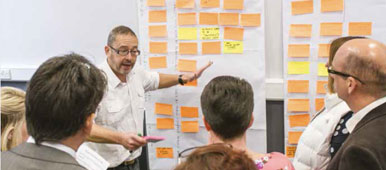
Translating to reality. Making it happen.

My wife gifted me a driving experience at a local racing track for a recent birthday. Part of this experience was to drive a range of vehicles including a magnificent Ferrari. I can promise you it was everything you dreamed of and more, from the sleek lines, smell of the leather seats, to the tenor of the engine. As I reflected on the excellent design and craftsmanship I began thinking about organisation design, at one point this impressively designed car was just a thought and a sketch on a piece of paper. So how did they get from paper to this splendid product? Similarly how do you translate your brilliant strategic thinking from paper, and models into the reality of your organisation? That’s a big question deserving at least 3 PHD’s but being a practical guy I want to focus on using one really helpful and valuable tool, called design criteria.
Design criteria are a critical step in translating the concepts and ideas from your organisations strategy into the future organisational capabilities. In a car these capabilities would be called features such as the radio, engine, interior, it’s the combination of these features which deliver the desired experience. Creating these criteria with those affected by the redesign:
- Helps build understanding of the strategy.
- Clarifies what capabilities will be required to fulfill the strategy.
- Tests the reality of the strategy with what capabilities are available, what new capabilities may need to be developed or if the strategy is unrealistic.
- Gives an objective guide to inform design decisions and to assure the design during implementation.
- Allows you to clearly work out the key milestones and activities to measure.
- Engages people and creates momentum, as Weisbord says, “people own what they create.”
The Figure 1 describes an example set of design criteria created across multiple organisations within a health system to support patient care. Each of the below design criteria completes the statement, “our health and care system is able to…”
Figure 1 – Example Design Criteria from a health project

So what makes a great set of criteria? Based on both my and the European Organisation Design Forum community blood, sweat and tears here’s a selection of insights.
- As I said above, the criteria need to translate your strategy into the practical features (capabilities) of your future organisation. Such as if your strategy is to enter a new market then a design criteria may be to: create alliances with complimentary organisations in that market
- Create design criteria at the highest system level within scope first then an aligned/ nested set of design criteria appropriate for each level below in scope, like Russian nesting dolls.
- Include the core polarities which your organisation will need to manage such as centralising for economies of scale AND decentralising to be more customer focused
- Build in good practice capabilities from industry that keep you competitive and your chosen innovative capabilities that give you an advantage
- Use less than 7 design criteria per system level/team, to ensure the most important issues are resolved, for ease of communication and recall
- Be brief, fact based, action oriented, and use imagery to helpfully explain and communicate the design criteria
Successful organisation designs require strong design criteria as a foundation to build from. Creating these with those affected in a safe environment, allowing rigorous debate will allow vital issues to be addressed early on and minimise any anxiety and politics emerging later in the design process.
This article was first published in our Cocooners N° 2





